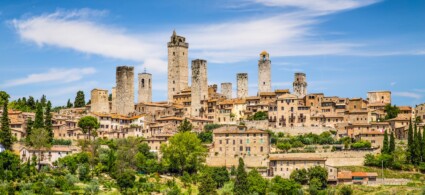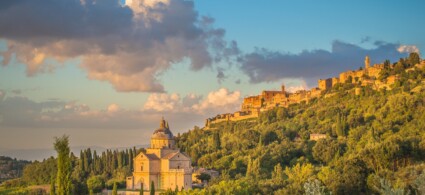

A holiday in Tuscany cannot be separated from a visit to a historical village: Tuscan villages are one of the most appreciated wonders of all visitors to this magnificent region.
You can find them everywhere, from north to south and from east to west: perched on top of gentle hills planted with olive trees and vineyards, in the middle of valleys and wheat fields, at the foot of green mountains or along breathtakingly beautiful coastal stretches.
The typical image is that of the walled town that preserves its medieval appearance intact, but not all towns in Tuscany are towers and castles. For instance, some have a typically Renaissance layout, characterised by elegance and harmony; others have sprung up next to thermal springs known since ancient times.
Which villages should you include in your Tuscany itinerary? You can give yourself a geographical criterion, focusing on a precise area, which could be the Val d’Orcia, the Garfagnana, the Val d’Elsa… Or create a thematic itinerary, for example a wine and food tour of the Chianti region, a seas and mountains holiday or a spa and art holiday.
To help you choose, we have selected for you the 15 most beautiful villages in Tuscany: a list from which you can take inspiration to organise a weekend or a holiday tailored to your tastes and interests.
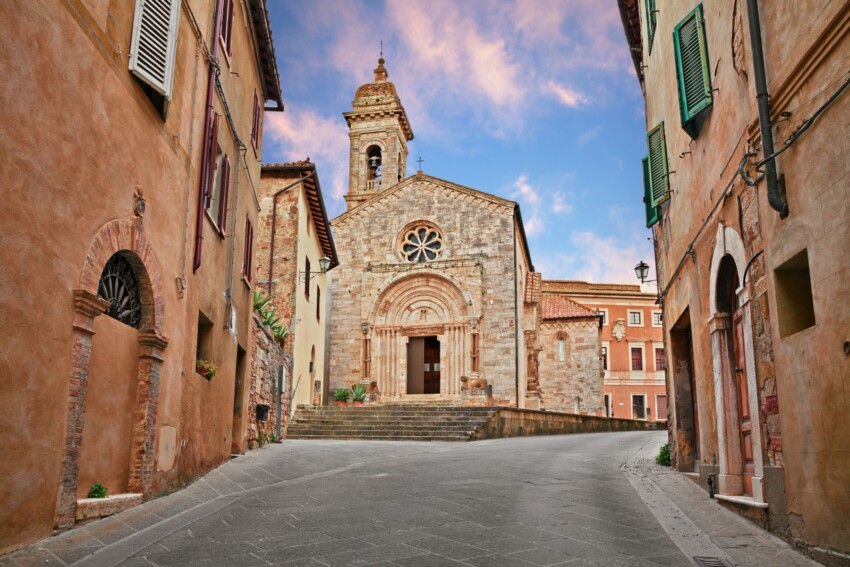
Green, yellow, white and pinkish are the colours that make up the palette of San Quirico d’Orcia: the light green of the meadows and the dark green of the cypresses, the golden yellow of the sunflowers and the fields ripe in summer, the white of the winding streets that run through the hills, the pinkish of the historic stone buildings.
This pretty walled town perched on a low hill is the quintessence of picture-postcard Tuscany and is undoubtedly one of the must-see villages in the province of Siena.
It is an ideal base for exploring the Val d’Orcia, an enchanting rural area in southern Tuscany famous for its gentle landscape, to be admired during a slow-paced drive or motorbike tour. Before your eyes will flow expanses of vineyards, olive groves and cultivated fields interrupted here and there by a small village, a castle, an ancient church.
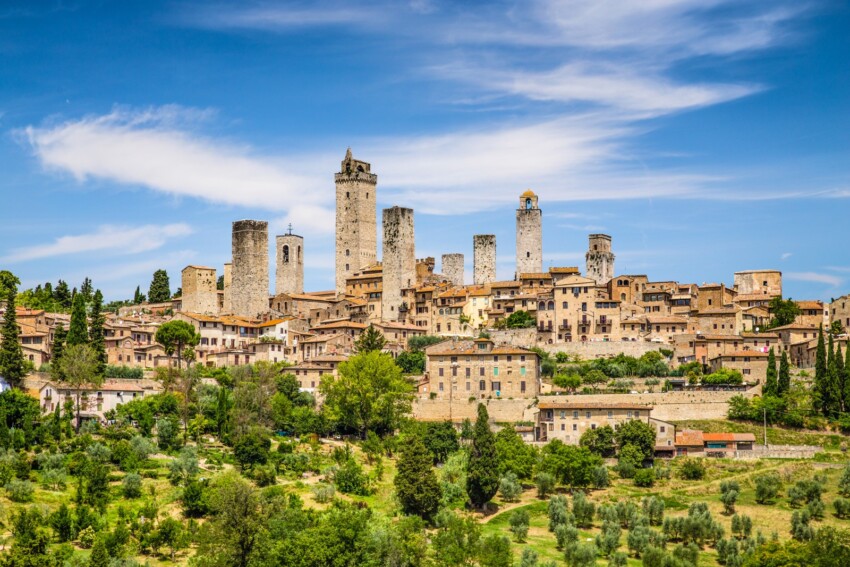
You can recognise the town of San Gimignano from afar, announced by its 13 towers soaring high into the sky. Stretched out towards the blue, almost as if competing to see who is taller, they are an impressive sight… and to think that they are only a fraction of the towers that once stood in the town (an estimated 72)!
Located in the north-western part of the province of Siena, considered the medieval heart of Tuscany, San Gimignano is one of the most visited villages in Tuscany and is definitely a stop on your trip if you love towers, walls, gates and ancient buildings. The town experienced an economic decline during the Renaissance period and this has preserved its medieval appearance intact.
Another recommended area for a Tuscany itinerary by car or Vespa is the Chianti region, the area between Siena and Florence where the most famous Italian red wine abroad is produced. The entire region can be visited in two days by following the Chiantigiana: there are several routes, the classic one starts from Impruneta.
If you have little time and want to visit just one village, Greve in Chianti is a good choice. Like the other Chianti villages, it has a characteristic medieval centre full of wine bars, restaurants and shops where you can buy typical products. In addition, there is an interesting Wine Museum founded by a local farm that tells of the stages of wine production and the evolution of production techniques.
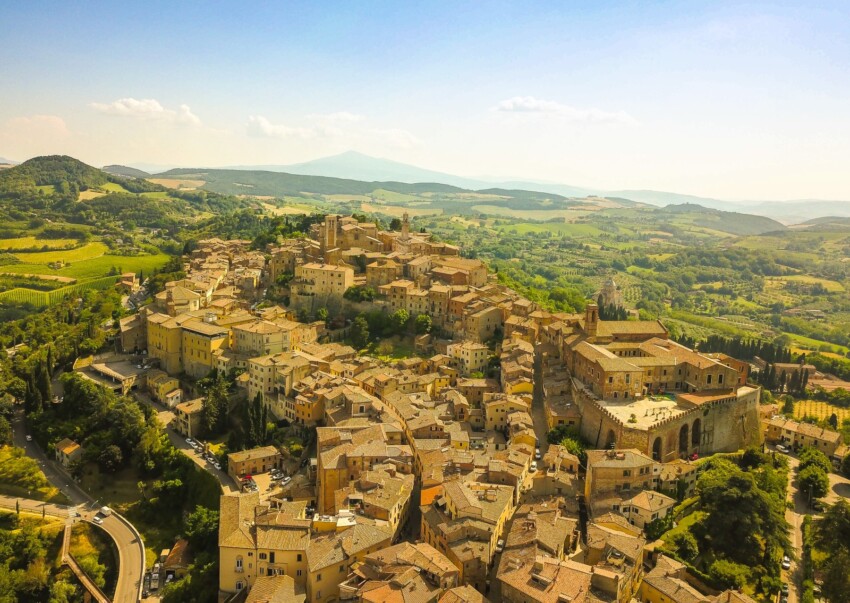
The name of another famous Tuscan wine identifies Montepulciano, a poetic village nestled among gentle hills in the southern part of the province of Siena, almost on the border with Umbria.
Nestled in the gentle rural landscape of the Sienese countryside, Montepulciano is a magnificent panoramic balcony: from its houses and terraces one can admire splendid views of the Val d’Orcia and the Valdichiana.
The historical centre is full of medieval and Renaissance palaces and churches, and of course there are wine bars and restaurants where you can taste the excellent local wine.

We conclude the triptych of villages not to be missed during a wine tour of Tuscany with Montalcino, whose fame is inextricably linked to Brunello wine. It is less than 40 km from Montepulciano and it is therefore possible to visit both villages in one weekend.
Almost everyone comes here for the wine shops, but Montalcino is not only wine: it is also art, history, panoramic views and cultural events.
The town is enclosed within a mighty wall, still well preserved. Its landmark building is the Rocca, an austere medieval fortress that in July becomes an exceptional location for the exciting Jazz & Wine Festival.
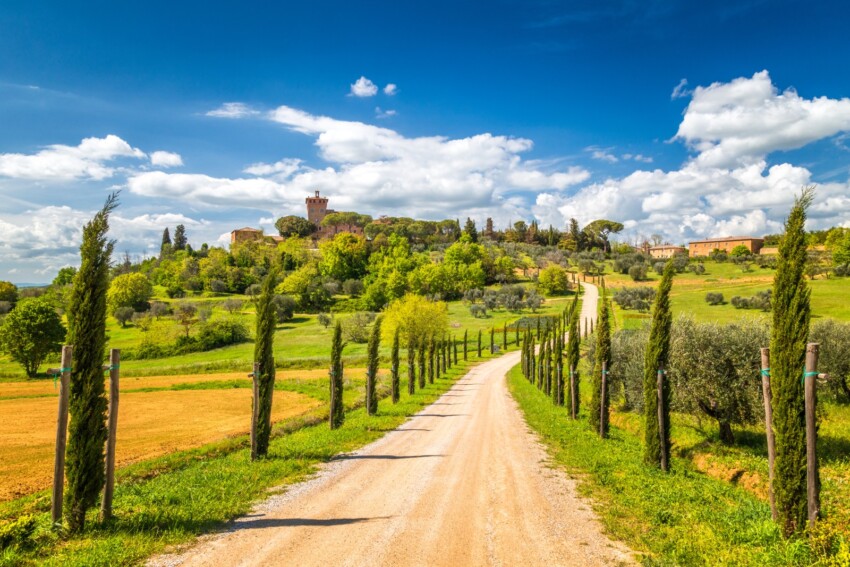
If the Middle Ages are a bit narrow for you and you prefer the harmonious and elegant beauty of the Renaissance, put Pienza, the ideal city commissioned by Enea Silvio Bartolomeo Piccolomini, better known as Pope Pius II, on your agenda.
One of the most influential pontiffs of the 15th century, and a great connoisseur of Latin and Greek culture, Pius II wanted to transform his birthplace – which was at the time a humble hillside village – into a city in keeping with the philosophy of the classical age and the aesthetic canons of the Italian Renaissance. His grandiose vision gave life to a harmonious complex of elegant buildings that we can still admire today.
Pienza is also a must for all gourmet travellers: it is the home of the famous Pecorino di Pienza cheese and other tasty local products.
Certaldo is one of the most charming villages in the Val d’Elsa, another area with splendid rural landscapes between Siena and Florence.
Awarded the Orange Flag by the Italian Touring Club, the village is divided into an upper part, which corresponds to the historic centre, and a more recent lower part. The historic core is enclosed within walls with three gates.
Certaldo is known as the birthplace of Giovanni Boccaccio, one of the fathers of Italian literature. The birthplace of the Certaldese, as the well-known writer is called, is still standing and has been converted into a museum.

A journey into the varied and very tasty world of Tuscan food and wine cannot fail to include San Miniato, the famous white truffle town located between Pisa and Florence.
It is a slow destination for those who want to forget the hustle and bustle of modern life by savouring life’s little pleasures: good food, the beauty of the landscape, chatting and smiling with the locals.
Like all Tuscan villages, San Miniato is also rich in history and art. Among the many historical and cultural attractions in San Miniato are the Fortress of Frederick II with its landmark tower and the Cathedral with its façade decorated in ceramics reproducing the Ursa Major and Minor.
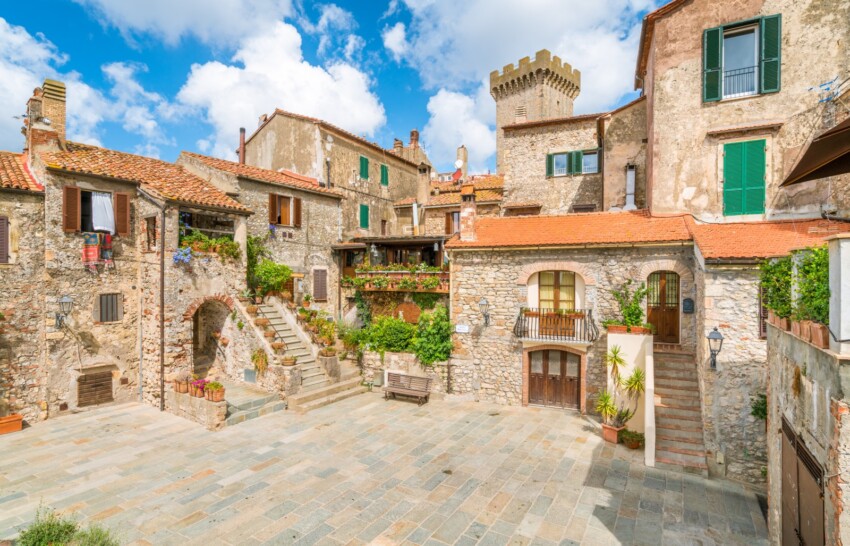
The Tuscany of seaside holidays is not without fascinating historic villages. One of the best-known places in the Maremma, the wide coastal area stretching from west-central Tuscany to Lazio, is Capalbio: a classic medieval village perched on a hill a few kilometres from the beaches.
The landscape you admire while walking along the walls of Capalbio is quite different from that of the Val d’Orcia or the Chianti region. Before your eyes is a plain that reaches down to the sea; few olive trees and vineyards, here it is the Mediterranean maquis that dominates the landscape.

Another location in the Maremma region of Grosseto that allows you to combine sea and romantic atmospheres of bygone days in a single holiday is Castiglione della Pescaia, a delightful historic village nestled along a promontory overlooking the sea.
The top attractions of Castiglione della Pescaia are two: the Aragonese Castle at the top of the promontory, a magnificent vantage point from which to observe the blue expanse of the Tyrrhenian Sea, and the long sandy beaches, suitable for all tastes, from those equipped with many facilities to those that are free and quiet.
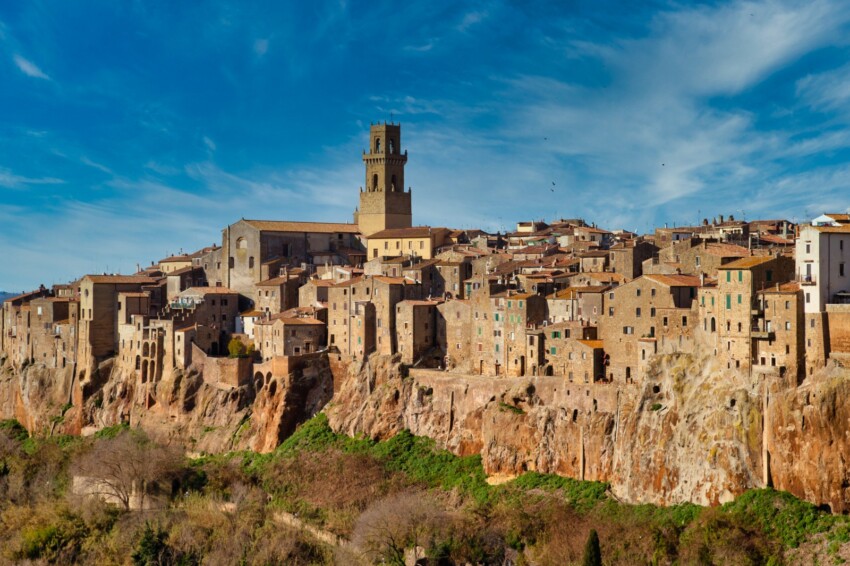
Observing it from a distance, Pitigliano may look like another of Tuscany’s many beautiful medieval villages. However, it is a special case, distinguished from the other villages by two main characteristics.
To begin with, the town is entirely excavated in tuff, built on a vertiginous vertical wall: its houses seem to be the natural continuation of the tuff wall.
The other peculiarity is the presence of an interesting Jewish ghetto, the legacy of a large Jewish community that settled in Pitigliano in the 15th century. For this reason, the village is also known as Little Jerusalem.

Located about 40 km from Lucca, Castelnuovo is the unmissable place in Garfagnana, the part of northern Tuscany between the Apuan Alps and Versilia: it is a very green area, rich in nature reserves perfect for exploring on foot or by bike.
The symbolic attraction of Castelnuovo di Garfagnana is the Rocca Ariostesca, a mighty castle with a trapezoidal plan dominating the central square; the name of the building is a tribute to Ludovico Ariosto: the poet author of Orlando Furioso was governor of Castelnuovo from 1522 to 1525.
Also worth seeing are the Duomo, also in the historical centre, and the Fortress of Mont’Alfonso, a short distance away.
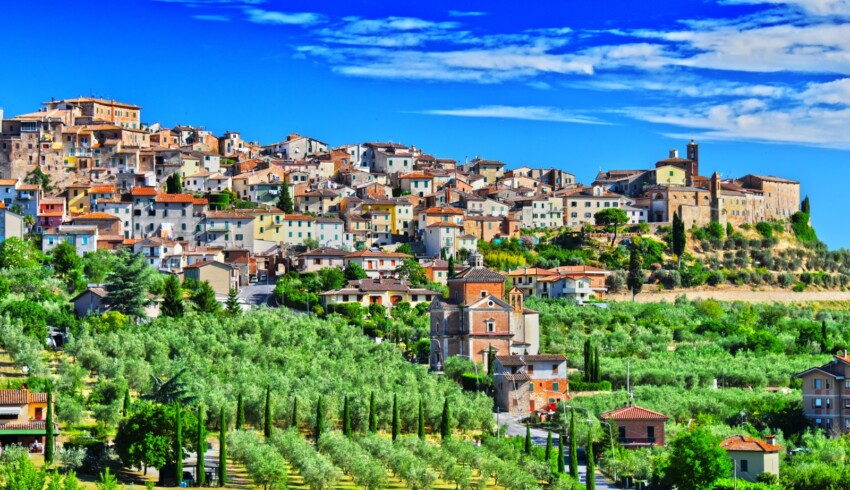
Of all the spa towns in Tuscany, Chianciano is the one that has best preserved its medieval appearance. Already known to the Etruscans and Romans for the healing properties of its waters, Chianciano Terme today presents itself as a medieval town rich in cultural attractions.
Before diving into the waters of the sensorial spa, it is worth visiting the historic centre and its interesting museums: the Museo Civico Archeologico delle Acque and the Museo d’Arte; the latter includes a section dedicated to ancient and one to contemporary art, and the Torre dell’Orologio.
Chianciano Terme is also a good base for exploring south-eastern Tuscany and Umbria by car or bicycle.

Less glamorous and perhaps less well-known than Chianciano, Montecatini and Saturnia, Bagno Vignoni is a uniquely charming Tuscan spa town. The town’s main square is almost entirely occupied by a 49-metre-long natural hot-water pool of ancient origin; around the pool stand traditional stone houses with a rustic and romantic appearance.
It is not possible to bathe in the pool in the central square, but it is possible to relax in the pools of the luxurious spa hotels in the surrounding area.
Following the flow of water from the central pool, you can instead reach the Parco dei Mulini, a complex of ancient mills, gorges and artificial canals that have ensured the town’s water supply over the centuries.

Cortona is one of the top towns in the province of Arezzo. We are in south-east Tuscany, almost on the border with Umbria: the shores of romantic Lake Trasimeno can be reached by car in less than half an hour. Splendid views of the Valdichiana with the lake in the distance can be admired from the village’s vantage points.
Although it is frequented by many VIPs – including Jovanotti, a super-famous Italian rapper and singer, who frequented it as a child with his family and who later settled there – Cortona is not at all fashionable, rather it maintains the simple and relaxed lifestyle that is typical of Tuscan villages.
